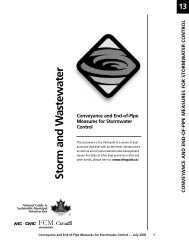The State of Canada's Cities and Communities 2012 - FCM
The State of Canada's Cities and Communities 2012 - FCM
The State of Canada's Cities and Communities 2012 - FCM
Create successful ePaper yourself
Turn your PDF publications into a flip-book with our unique Google optimized e-Paper software.
Chapter 5<br />
Page 2<br />
QOLRS IN BRIEF: RENTAL HOUSING<br />
A healthy housing sector that is able to meet<br />
a broad range <strong>of</strong> needs is a vital part <strong>of</strong> the<br />
economic <strong>and</strong> social wellbeing <strong>of</strong> a community.<br />
Canadians are currently facing rising costs <strong>of</strong><br />
homeownership, historically high levels <strong>of</strong> household<br />
debt, with residential mortgages making up<br />
68% <strong>of</strong> that debt, 2 <strong>and</strong> record high rental rates.<br />
Data collected across 27 communities through<br />
<strong>FCM</strong>’s Quality <strong>of</strong> Life Reporting System reveal<br />
that since 2005 homeownership costs have risen<br />
at a rate nearly three times greater than income<br />
levels. 3 In the past decade, construction <strong>of</strong> purpose<br />
built rental housing has flat-lined at 10% <strong>of</strong><br />
all new housing starts, while existing rental stock<br />
is diminishing through erosion <strong>and</strong> conversion<br />
to condominium housing. 4 <strong>The</strong> average cost <strong>of</strong><br />
renting in QOLRS communities has increased<br />
by more than 20% since 2000. 5<br />
Rental housing is an <strong>of</strong>ten overlooked yet important<br />
component <strong>of</strong> Canada’s housing system.<br />
One-third <strong>of</strong> Canadians are renters. This includes<br />
young Canadians, creating new renter households<br />
when they leave the family home; older<br />
Canadians, seeking apartment living when they<br />
no longer need or want to maintain larger family<br />
homes; <strong>and</strong> new Canadians, a critical component<br />
<strong>of</strong> our future labour force, many <strong>of</strong> whom initially<br />
rent before they transition to home ownership.<br />
<strong>The</strong> <strong>FCM</strong>’s recent report, <strong>The</strong> Housing Market<br />
<strong>and</strong> Canada’s Economic Recovery, points to<br />
changing global economic conditions that reflect<br />
changing housing needs in Canada. 6 <strong>The</strong>se conditions<br />
have created a gap in the construction<br />
<strong>and</strong> housing sectors that can most readily be<br />
filled by purpose-built rental housing. <strong>The</strong> report<br />
proposes an array <strong>of</strong> tax incentives to stimulate<br />
the construction <strong>of</strong> new rental units <strong>and</strong> preserve<br />
existing rental stock.<br />
With the cost <strong>of</strong> home ownership out <strong>of</strong> reach<br />
for an increasing number <strong>of</strong> moderate <strong>and</strong> lowincome<br />
earners, <strong>and</strong> thous<strong>and</strong>s more on growing<br />
affordable housing wait lists, rental housing is a<br />
vital component <strong>of</strong> a healthy housing sector that<br />
can no longer be ignored.<br />
This QOLRS In Brief report looks at current<br />
trends in rental housing <strong>and</strong> homeownership<br />
in municipalities across Canada. It provides<br />
snapshots <strong>of</strong> initiatives introduced by QOLRS<br />
member cities <strong>and</strong> regions designed to increase<br />
investment in purpose-built rental <strong>and</strong> affordable<br />
housing that meets a broad range <strong>of</strong> housing<br />
needs <strong>and</strong> encourage a healthy housing sector.<br />
While economic <strong>and</strong> demographic circumstances<br />
vary regionally, together we share the goal <strong>of</strong><br />
making safe, affordable housing accessible to<br />
all residents.<br />
2 Canada Mortgage <strong>and</strong> Housing Corporation (CMHC), ‘Household Indebtedness,’ Canadian Housing Observer 2011. Pg. 1. Available online at http://www.<br />
cmhc.ca/en/corp/about/cahoob/upload/Chapter_3_EN_dec16_w1 .pdf.<br />
3 <strong>The</strong> mean price <strong>of</strong> a new home in the QOLRS was $406,760 in 2006 <strong>and</strong> $526,523 in 2010, an increase <strong>of</strong> 29.5%. Average income in the QOLRS rose<br />
from $64,790 in 2005 to $72,059 in 2009, an increase <strong>of</strong> 11.2%. All figures are in nominal dollars (not adjusted for inflation).<br />
4 CMHC measurements <strong>of</strong> new purpose-built rental starts include privately-initiated rental apartment structures <strong>of</strong> three or more units <strong>and</strong> exclude the<br />
secondary rental market, including public housing, row housing rental units, rented rooms in houses, units in buildings with 2 units or less <strong>and</strong> rented<br />
condominiums. While difficult to measure, changes in the secondary rental market may not address the type <strong>of</strong> housing need created by a decline in<br />
new rental housing starts.<br />
5 Mean rent in the QOLRS for a 2 bedroom increased from $715 in 2001 to $891 in 2010 <strong>and</strong> from $670 in 2001 to $827 in 2010 in all <strong>of</strong> Canada. Source:<br />
Canada Mortgage <strong>and</strong> Housing Corporation, Rental Housing Survey, 2001-2010. All figures in non-adjusted dollars.<br />
6 Federation <strong>of</strong> Canadian Municipalities, ‘<strong>The</strong> Housing Market <strong>and</strong> Canada’s Economic Recovery’ January <strong>2012</strong>.

















